
Gian LorenzoBernini was an Italian sculptor and architect. While a major figure in the world of architecture, he was more prominently the leading sculptor of his age, credited with creating the Baroque style of sculpture.

Palazzo Farnese or Farnese Palace is one of the most important High Renaissance palaces in Rome. Owned by the Italian Republic, it was given to the French government in 1936 for a period of 99 years, and currently serves as the French embassy in Italy.
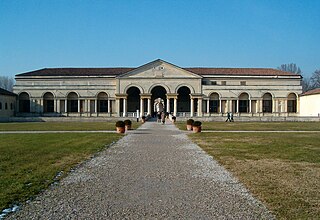
Palazzo del Te, or simply Palazzo Te, is a palace in the suburbs of Mantua, Italy. It is an example of the mannerist style of architecture, and the acknowledged masterpiece of Giulio Romano.
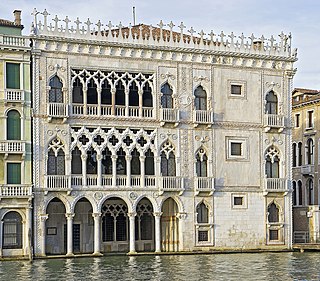
The Ca' d'Oro or Palazzo Santa Sofia is a palace on the Grand Canal in Venice, northern Italy. One of the older palaces in the city, its name means "golden house" due to the gilt and polychrome external decorations which once adorned its walls. Since 1927, it has been used as a museum, as the Galleria Giorgio Franchetti.

Frans Floris, Frans Floris the Elder or Frans Floris de Vriendt was a Flemish painter, draughtsman, print artist and tapestry designer. He is mainly known for his history paintings, allegorical scenes and portraits. He played an important role in the movement in Northern Renaissance painting referred to as Romanism. The Romanists had typically travelled to Italy to study the works of leading Italian High Renaissance artists such as Michelangelo, Raphael and their followers. Their art assimilated these Italian influences into the Northern painting tradition.

The art of Ancient Rome, and the territories of its Republic and later Empire, includes architecture, painting, sculpture and mosaic work. Luxury objects in metal-work, gem engraving, ivory carvings, and glass are sometimes considered to be minor forms of Roman art, although they were not considered as such at the time. Sculpture was perhaps considered as the highest form of art by Romans, but figure painting was also highly regarded. A very large body of sculpture has survived from about the 1st century BC onward, though very little from before, but very little painting remains, and probably nothing that a contemporary would have considered to be of the highest quality.

The Palazzo Pitti, in English sometimes called the Pitti Palace, is a vast, mainly Renaissance, palace in Florence, Italy. It is situated on the south side of the River Arno, a short distance from the Ponte Vecchio. The core of the present palazzo dates from 1458 and was originally the town residence of Luca Pitti, an ambitious Florentine banker.

Museo di Capodimonte is an art museum located in the Palace of Capodimonte, a grand Bourbon palazzo in Naples, Italy designed by Giovanni Antonio Medrano. The museum is the prime repository of Neapolitan painting and decorative art, with several important works from other Italian schools of painting, and some important ancient Roman sculptures. It is one of the largest museums in Italy. The museum was inaugurated in 1957.
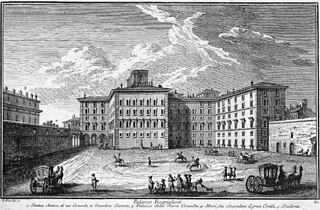
The Palazzo Pallavicini-Rospigliosi is a palace in Rome, Italy. It was built by the Borghese family on the Quirinal Hill; its footprint occupies the site where the ruins of the baths of Constantine stood, whose remains still are part of the basement of the main building, the Casino dell'Aurora. Its first inhabitant was the famed art collector Cardinal Scipione Borghese, the nephew of Pope Paul V, who wanted to be housed near the large papal Palazzo Quirinale. The palace and garden of the Pallavicini-Rospigliosi were the product of the accumulated sites and were designed by Giovanni Vasanzio and Carlo Maderno in 1611–16. Scipione owned this site for less than a decade, 1610–16, and commissioned the construction and decoration of the casino and pergolata, facing the garden of Montecavallo. The Roman palace of this name should not be mistaken for the panoramic Villa Pallavicino on the shores of Lake Como in Lombardy. The Palace has also been the scene of important cultural and religious events. On June 6, 1977 Princess Elvina Pallavicini invited in Palazzo Pallavicini Rospigliosi the archbishop monsignor Marcel Lefebvre for a conference on the Second Vatican Council and for the celebration of a Traditiona Mass, under the careful direction of the marquis Roberto Malvezzi, and Frigate Captain marquis Luigi Coda Nunziante di San Ferdinando. Many members of Alleanza Cattolica, the baron Roberto de Mattei, the pharmacologist Giulio Soldani, the sociologist Massimo Introvigne, the psychiatrist Mario Di Fiorino and Attilio Tamburrini and his brother Renato Tamburrini took part to the event.

Palazzo Mozzi or Palazzo de' Mozzi is an early Renaissance palace, located at the end of the Piazza de' Mozzi that emerges from Ponte alle Grazie and leads straight to the palace where via San Niccolò becomes via de' Bardi in the Quartiere of Santo Spirito in the Oltrarno section of Florence, region of Tuscany, Italy. The 13th-century palace housed the gallery of the highly successful antiquarian Stefano Bardini, of which the remnants were left to the commune, where they assembled the Museo Bardini or Mozzi Bardini, displaying Florentine art and artifacts up to the early Renaissance. The gardens elaborated against the hillside behind the palace were added mainly by Bardini.

Ca' Pesaro is a Baroque marble palace turned art museum, facing the Grand Canal of Venice, Italy. Today it is one of the 11 museums run by the Fondazione Musei Civici di Venezia system.
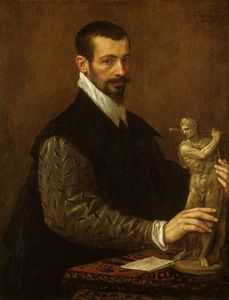
Tiziano Aspetti (1559–1606) was an Italian sculptor of the Renaissance. He was born in Padua and active mainly there and in Venice. He completed both large and small sculpture in bronze. Among his large works are bronze statues in the façade of San Francesco della Vigna and of Saint Anthony and many other sculptural decorations for the Basilica of Sant'Antonio of Padua.

Piazza della Repubblica is a city square in Florence, Italy. It was originally the site of the city's forum; then of its old ghetto, which was swept away during the improvement works, or Risanamento, initiated during the brief period when Florence was the capital of a reunited Italy—work that also created the city's avenues and boulevards. At that time, the Loggia del Pesce from the Mercato Vecchio was also moved to Piazza Ciompi. The square's Giubbe Rosse cafe has long been a meeting place for famous artists and writers, notably those of Futurism.
Bettina Werner is an Italian artist based in New York City. She has created artwork with her colorized salt technique since the early 1980s. Werner became an American citizen in July 2010 and now bears dual citizenship.
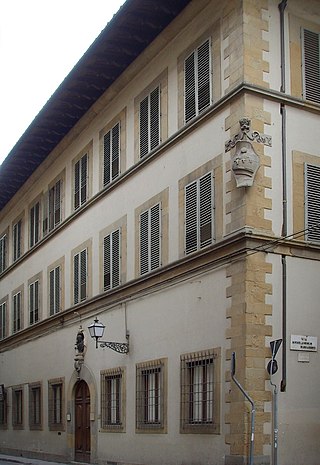
Casa Buonarroti is a museum in Florence, Italy that is situated on property owned by the sculptor Michelangelo that he left to his nephew, Leonardo Buonarroti. The complex of buildings was converted into a museum dedicated to the artist by his great nephew, Michelangelo Buonarroti the Younger. Its collections include two of Michelangelo's earliest marble sculptures, the Madonna of the Stairs and the Battle of the Centaurs. A ten-thousand book library includes the family archive and some of Michelangelo's letters and drawings. The Galleria is decorated with paintings commissioned by Buonarroti the Younger and was created by Artemisia Gentileschi and other early seventeenth-century Italian artists.

The Vision of Constantine is an equestrian sculpture by the Italian artist Gian Lorenzo Bernini, located in the Scala Regia by St. Peter's Basilica in Vatican City. Originally commissioned as a free standing work of art within St. Peter's itself, the sculpture was finally unveiled in 1670 as an integral part of the Scala Regia - Bernini's redesigned stairway between St. Peter's Basilica and the Vatican Palace. Unlike other large works by Bernini, art historians have suggested that this work was almost entirely undertaken by him - no other sculptors have been recorded as receiving payment. Bernini's overall fee was 7,000 Roman scudi.

The Pinacoteca Comunale ofCittà di Castello is the main museum of paintings and arts of Umbria Italian Region, alongside the Perugia's National gallery, and it's housed in a renaissance palace, generally preserved in its original form.

Palazzo dei Convertendi is a reconstructed Renaissance palace in Rome. It originally faced the Piazza Scossacavalli, but was demolished and rebuilt along the north side of Via della Conciliazione, the wide avenue constructed between 1936 and 1950, which links St Peter's Basilica and the Vatican City to the centre of Rome. The palace is famous as the last home of the painter Raphael, who died there in 1520.
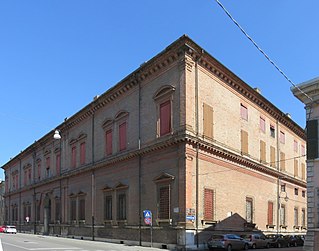
The Palazzo Massari, also known as the Palazzo Rosso, is a Renaissance-style palace located on Borso and Corso Porta Mare, at the northwest corner of Piazza Ariostea, in Ferrara, region of Emilia-Romagna, Italy.

Rinaldo Carnielo (1853–1910) was an Italian sculptor known for his macabre sensibility.



















